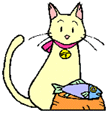Vol. 2, No. 14
Table of Contents
Feline Nutrition: I’m not Hungry!
Assist Feeding: Site Infection
Kitty Potpourri: Tabby Cats are the Best
Best Cat Food: Brand-X
Caring for Cats: Proactive Plan: Step 10
Feline Nutrition
I’m not hungry!
by Garry White
Most of us already know that cats will stop eating or lose interest in food for a number of reasons: Ailments, disease, type of food, mating ritual, fear or intimidation by other animals, a new and strange home, even a new addition to the family. It doesn’t take much to upset a cat’s biological or emotional balance, and appetite always takes the hit first. Of course we’re concerned about why they’ve stopped eating, but right now our primary concern is that they have, and what to do about it. First off, we face the dilemma with a single goal: Get proper nutrition inside this cat every day. However, if the underlying reason for not eating is an ailment or condition that requires (or cannot tolerate) certain nutrients or ingredients, then we have to consider that too.
One approach is the commercially available nutrition supplements. If you’ve gone this route and they worked, then all to the good. But understand that I’m not a fan of these things. They’re primarily sugar-based goo, loaded with calories, and as with humans and sweet treats.sugar serves to deter appetite, not enhance it. Plus, excess sugar is bad for plenty of other reasons. Plus, the carrier (the suspension) often causes diarrhea, which defeats the whole purpose of keeping nutrition inside the cat.
Another approach are vet-prescribed ‘appetite enhancing’ drugs. Again, in dire straights we do whatever we feel will help, but the downside to these drugs is more often detrimental than beneficial.vomiting, diarrhea, and a host of other reactions are not uncommon.
So, with some of the conventional methods less than desirable, we’re left to consider a more natural way to deal with this, and that’s not such a bad thing. If you haven’t already done so, I strongly recommend that you experiment with syringe-feeding from time to time. It’s the first line of attack in assist-feeding a cat, and by experimenting you accomplish several things: One, you learn the process of blending foods and dealing with syringes (which most drug stores will give you). Two, Kitty is familiar with the process: If it ever becomes an absolute necessity, you aren’t imposing a strange, new process to an already-stressed cat. Three, if you discover that Kitty simply is not going to tolerate syringe-feeding, then you’ve learned that it’s not ever going to be a viable option; start looking for alternative methods.
But what to feed them?
Natural foods, maybe holistic foods, foods that you prepare or even semi-prepare, or maybe a combination. You may wish to induce a few nutrient supplements, such as Taurine, but remember: This is not a long-term dietary plan; it’s a means of getting temporary nutrition in the cat.
As for some ideas, here are a few things that I’ve had success with:
- Pan-fried beef liver (slow heat) with a tiny bit of unsalted butter. Used to be that butter was a no-no, but we’ve discovered that small amounts offer a fat that’s actually good for them. I mix the chopped liver with boiled, shredded chicken, and then add a little water. Set the mix in the fridge for a day so the juice takes on a flavor.
- Another one my guys like: It starts with peas, cooked carrots, and boiled potatoes blended into a smooth mush. I add a few tablespoons of cottage cheese, some chopped boiled egg-whites, and some shredded chicken.
Here’s one I grabbed from an Internet site.looks pretty good to me, but be sure you read the label on the baby food jars.no onions or onion powder:
Mix equal parts of –
-
- Beechnut baby food – lamb or veal
- Gerbers rice cereal
- 1/4 cup KMR (Kitten Milk Replacer) or Evaporated Milk
- (mixed half and half with water)
- Give twice a day
The options go on to infinity, and if you’re clever (which I already know you are), you’ll experiment with these things before you actually need to, because.If Kitty doesn’t like a food when he’s feeling good, he’ll like it even less when he’s sick.
Assist Feeding
Site Infection
by Kathy Fatheree
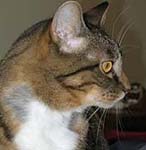 Hi Everyone! I just got back from a week at my sister’s and I’m exhausted! My sister went into labor early and so it was a mad dash to get there in time. We (my mom and I) were originally going to fly out of our local airport, but since labor came early we had to drive several hours to catch a plane at a different airport then take a cab to the Greyhound station and take a bus into my sister’s small town. It was a mess!! Anyway I have a gorgeous new baby nephew!
Hi Everyone! I just got back from a week at my sister’s and I’m exhausted! My sister went into labor early and so it was a mad dash to get there in time. We (my mom and I) were originally going to fly out of our local airport, but since labor came early we had to drive several hours to catch a plane at a different airport then take a cab to the Greyhound station and take a bus into my sister’s small town. It was a mess!! Anyway I have a gorgeous new baby nephew!
About Bert! He’s doing fantastic. In fact I would say that besides not eating he is 100% back to his old self! He’s driving us crazy lately! He’s been nocturnal for the last week or so and has been getting feisty right around the time we’re going to bed. Mitch said the entire week I was gone as soon as he went to bed Bert would get up and do his ‘mrrrooowww’ meow for 20 minutes. You know that deep guttural meow? I think he just missed me! 😉 Another thing he’s been doing is sleeping ON us. He usually curls up under covers with us but lately he’s taken to sleeping on our head on top of our pillow. Also I’ve woken up and found him half on Mitch’s pillow and half on his shoulder/chest. Who knows what that lunatic is doing! It’s adorable but we’re still not getting any sleep because of Bert!! As soon as we get the all clear we might just lock his little chubby butt out of the bedroom for a night! Okay not really but it’s a very satisfying thought! 🙂
He’s active and plays with anything he can get his little paws on. He’s using the litter box regularly, which we’ve moved back into the other bedroom. He has to walk past the water and food bowls to get to the litter boxes and doesn’t seem to mind at all! He’s bright eyed and alert, his fur is shiny and soft and he’s still gaining weight!
Site Infection
Mitch took him in for his blood tests on Friday and we heard back today from LaLania; She said that his enzymes are still ‘slightly elevated’ but well within healthy levels. They want us back in two weeks for some more tests but both LaLania and Dr. Smith said he looks fantastic! His tube site has a small infection 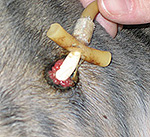 that we’re treating with Neosporin. Dr. Smith said that he had never seen this type of infection,it almost looks like some stomach tissue is coming out through the site. It’s red and irritated but since we’ve been using the antibiotic cream it’s doing much better.
that we’re treating with Neosporin. Dr. Smith said that he had never seen this type of infection,it almost looks like some stomach tissue is coming out through the site. It’s red and irritated but since we’ve been using the antibiotic cream it’s doing much better.
Kitty Potpourri
Tabby Cats are the Best!
by Dan Malenski
Now we know what you are thinking; that is, the title of this week’s article is just a boast from one of my two assistants, being that both are tabby cats, but did you know that all cats are genetically tabby cats. Therefore, what we are actually saying is that all cats are the best-and who is going to argue with us on that point! This week we will talk about the color of the luxurious coats our feline companions wear, and in the process, you will then see why a black cat is still genetically a tabby cat! We will focus on the tabby cat pattern being that nearly all others are based on it.
The tabby cat striping is nature’s camouflage for the cat, which helps it to approach its prey unobserved or elude a pursuer. There are four primary types of tabby cat markings: Abyssinian, classic, mackerel, and spotted. The Abyssinian pattern is a muted pattern, that is, the tabby cat pattern is only evident on the head and sometimes on the tail and/or legs. Think of a leopard when describing the spotted pattern. The mackerel tabby cat has stripes that radiate from the spine to the belly just like that of the fish! The stripes of a classic tabby cat are much wider than that of the mackerel, and lend the pattern a more random appearance. Classic tabby cats are also known as blotched tabby cats in some circles. The photograph on the left beneath this paragraph is an example of a mackerel tabby cat; the one on the right is a classic tabby cat.
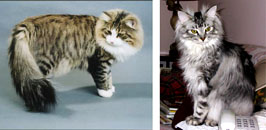
Another form of tabby cat striping, although not a basic type, is the patched tabby cat. I mention this out of consideration to Melissa who likely will stop speaking to me if I don’t. An alternate term for a patched tabby cat is a torbie, but do not confuse this term with tortie, which still is another pattern, although similar, that stems from genetics. A tabby cat is designated a torbie (patched tabby cat) if it has patches of red or cream on its body or if its nose leather and/or paw pads have two different colors. Our own Melissa is a blue patched tabby cat and the end of this paragraph shows her hard at work at the computer, performing research for next week’s article or trying to catch “Felix the Cat” on the screen-I cannot tell which!
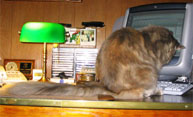
Cats have a second form of camouflage named agouti banding. A close look at one of the lighter hairs between the stripes of a tabby cat will reveal hairs that are not solid in color. Each hair will have a light band below a dark tip, which imparts a salt-and-pepper appearance. Cats with solid color coats have the tabby cat gene, as all cats do, and the reason why their coat appears solid is that they do not have the gene that caused agouti banding, but an alternate non-agouti form. Cats with the non-agouti form do not have the light colored banding on the hairs between the tabby cat stripes; thus, they appear solid in color and, in effect, mask the tabby cat stripes. Those cats are still genetic tabby cats, but you cannot see the stripes because of this masking.
Finally, we all know that a cat’s coat protects them from the elements and varies in density, which gives us plenty of practice brushing fur off the furniture in the spring and fall when they “change coats.” How many think that this change of coats is due to temperature change? Well, it’s actually the length of daylight exposure has the strongest influence. This cycle of shedding is not nearly as prominent for indoor cats because of their artificial environment; thus, most will shed their coats moderately on a year round basis. Now, when someone questions that omnipresent fur on our clothing, we not only will be able to tell him or her where it came from, but why we “wear” it every day!
Best Cat Food
Brand-X
by Garry White
Each week we are having our own cat food reviews to determine what we, or should I say, our kitties think is the best cat food.

True Story
Researching and reporting on quality cat foods for you is certainly rewarding, but I confess that it can also be entertaining at times. Recently, I spotted a food on the Internet that looked worthy of more inquiry, so I called the company, and the dialogue went something like this: The phone was answered by an unearthly screeching sound, followed by a woman yelling at Ben to stop pulling Angie’s hair, and put her back in the !%$*# crib! Then..
“Yuh?”
“Hi, my name is Garry; is this the ___ pet food company?”
“Yuh.”
“I see. Well, look, I write for a newsletter and I saw your website. It says that you
manufacture holistic cat food; is that right?”
“Yuh.”
“Hey, that’s great! Could I speak to someone about the foods?”
“Yuh.”
“Okay.would that be you?”
“No, I don’t know nuthin’ about it.”
“All right, then who would I talk to about it?”
Without covering the phone, she screams at Ben to put the baby down and go get his $#^@! father; some guy on the phone is asking about cat food. She drops or throws the phone onto what must have been a hard surface, and several very long minutes later, a male voice comes online.
“Yuh?” (Wanna guess what I was thinking?)
“Hi.you manufacture holistic cat food, right?”
“Yuh.”
“Great! Can you tell me a little bit about it?”
“No, you’d have to ask them.”
“Uh, and who would ‘them’ be?”
“Them; the ones in Dallas, I guess.”
“I see. But I thought you manufacture it.?”
“Yuh.”
“So then, you do actually manufacture the food?”
“Yuh.”
“Then why do I need to talk to people in Dallas?”
“Maybe it ain’t Dallas. Seems like it was, though.”
“Well, I don’t think we’re getting anywhere with this, do you?”
“Yuh. You need any horse feed?”
“Not today.”
On the serious side: I have some nifty, holistic cat treats coming your way soon.just waiting for the samples and the nutrient profiles.
Caring for Cats
Proactive Plan: Step-10
by Garry White
Understanding blood-test values (continued)
[PLT] 120-500
Platelet
Non-nucleated disk-shaped cells formed in the megakaryocyte and found in the blood of all mammals. They are mainly involved in blood coagulation.
[RBC] 4.0-9.0
Red Blood Cell
The blood cell that carries oxygen. Red cells contain hemoglobin and it is the hemoglobin which permits them to transport oxygen (and carbon dioxide). Hemoglobin, aside from being a transport molecule, is a pigment. It gives the cell its red color (and name).
[RDW] 8.0-12.0
Red Cell Distribution Width
A measurement of the variability of red blood cell size. Higher numbers indicate greater variation in size.
[TBIL] 0.1-0.6
Bilirubin
Test is for Jaundice: Yellow staining of the skin and sclerae (the whites of the eyes) by abnormally high blood levels of the bile pigment bilirubin. The yellowing extends to other tissues and body fluids. Jaundice was once called the “morbus regius” (the regal disease) in the belief that only the touch of a king could cure it.
When red blood cells are removed from the bloodstream, hemoglobin, the molecule in red cells that carries oxygen, is broken down into bilirubin. The bilirubin is carried to the liver and excreted into the intestine as a component of bile. Jaundice can indicate liver or gallbladder disease.
[TP] 5.4-8.2
Total Protein
Is a measure of total protein in the blood.
[WBC] 5.0-18.0
White Blood Cell
One of the cells the body makes to help fight infections. There are several types of white blood cells (leukocytes). The two most common types are the lymphocytes and neutrophils.(also called polymorphonuclear leukocytes, PMNs, or “polys”).
[VLDL]
Cholesterol
Very Low Density Lipoprotein – Another carrier of fat in the blood.
Disclaimer: Kathy Fatheree is not at all a medical expert. Contents of this web site are a collection of Kathy’s assist feeding experiences as well as the experiences of other cat owners who have assist fed their cats. While every effort has been made to ensure the accuracy of the information, Kathy Fatheree or anyone associated with this web site cannot be held responsible for anything that may happen as a result of using the information on this site.
